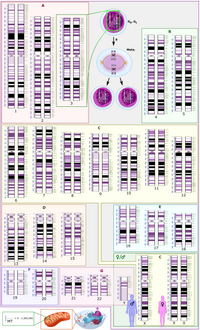
Photo from wikipedia
OBJECTIVES Phaeochromocytomas and paragangliomas (PPGL) are rare neuroendocrine tumours with malignant potential and a hereditary basis in almost 40% of patients. Germline genetic testing has transformed the management of PPGL… Click to show full abstract
OBJECTIVES Phaeochromocytomas and paragangliomas (PPGL) are rare neuroendocrine tumours with malignant potential and a hereditary basis in almost 40% of patients. Germline genetic testing has transformed the management of PPGL enabling stratification of surveillance approaches, earlier diagnosis and predictive testing of at-risk family members. Recent studies have identified somatic mutations in a further subset of patients, indicating that molecular drivers at either a germline or tumour level can be identified in up to 80% of PPGL cases. The aim of this study was to investigate the clinical utility of somatic sequencing in a large cohort of patients with PPGL in the United Kingdom. DESIGN AND PATIENTS Prospectively collected matched germline and tumour samples (development cohort) and retrospectively collected tumour samples (validation cohort) of patients with PPGL were investigated. MEASUREMENTS Clinical characteristics of patients were assessed and tumour and germline DNA was analysed using a next-generation sequencing strategy. A screen for variants within 'mutation hotspots' in 68 human cancer genes was performed. RESULTS Of 141 included patients, 45 (32%) had a germline mutation. In 37 (26%) patients one or more driver somatic variants were identified including 26 likely pathogenic or pathogenic variants and 19 variants of uncertain significance. Pathogenic somatic variants, observed in 25 (18%) patients, were most commonly identified in the VHL, NF1, HRAS and RET genes. Pathogenic somatic variants were almost exclusively identified in patients without a germline mutation (all but one), suggesting that somatic sequencing is likely to be most informative for those patients with negative germline genetic test results. CONCLUSIONS Somatic sequencing may further stratify surveillance approaches for patients without a germline genetic driver and may also inform targeted therapeutic strategies for patients with metastatic disease.
Journal Title: Clinical endocrinology
Year Published: 2021
Link to full text (if available)
Share on Social Media: Sign Up to like & get
recommendations!